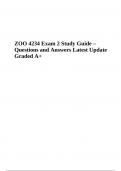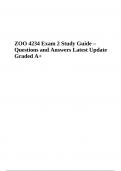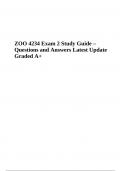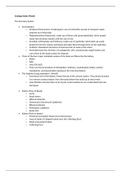Protonephridia Study guides, Class notes & Summaries
Looking for the best study guides, study notes and summaries about Protonephridia? On this page you'll find 9 study documents about Protonephridia.
All 9 results
Sort by

-
GENERAL BIOLOGY Exam Guide 2| Questions Answered 100% Correct/Verified Solutions
- Exam (elaborations) • 23 pages • 2024
- Available in package deal
-
- $12.99
- + learn more
protonema (protonemata) - ANSWER a mass of green, branched, one-cell-thick filaments produced by germinating moss spores protonephridium (protonephridia) - ANSWER an excretory system, such as the flame bulb system of flatworms, consisting of a network of tubules lacking internal openings proton-motive force - ANSWER the potential energy stored in the form of a proton electrochemical gradient, generated by the pumping of hydrogen ions (H+) across a biological membrane during chemiosmosis

-
General Biology UPDATED Test Questions And CORRECT Answers
- Exam (elaborations) • 22 pages • 2024
-
- $8.49
- + learn more
protonema (protonemata)a mass of green, branched, one-cell-thick filaments produced by germinating moss spores protonephridium (protonephridia)an excretory system, such as the flame bulb system of flatworms, consisting of a network of tubules lacking internal openings proton-motive forcethe potential energy stored in the form of a proton electrochemical gradient, generated by the pumping of hydrogen ions (H+) across a biological membrane during chemiosmosis protoplastthe living part o...

-
ZOO 4234 Exam 2 Questions and Answers Latest Update 2024 Graded A+
- Exam (elaborations) • 46 pages • 2023
-
- $17.99
- + learn more
ZOO 4234 Exam 2 Questions and Answers Latest Update 2024 Graded A+. Which of the following is NOT a characteristic of Platyhelminthes? a) Triploblastic b) Parenchyma c) Pseudocoelomate d) Dorsoventrally flattened e) None of the above Which of the following is a class belonging to the Phylum Platyhelminthes? a) Turbellaria b) Monogenea c) Cestoidea d) Trematoda e) All of the above Which of the following is NOT a class belonging to the Phylum Platyhelminthes? a) Monogenea b) Cestoide...

-
ZOO 4234 Exam 2 Study Guide – Questions and Answers Latest Update Graded A+
- Exam (elaborations) • 46 pages • 2023
- Available in package deal
-
- $15.49
- + learn more
ZOO 4234 Exam 2 Study Guide – Questions and Answers Latest Update Graded A+. Which of the following is a characteristic of Platyhelminthes? a) Most are parasitic b) Dorsoventrally flattened c) Triploblastic d) Acoelomate e) All of the above Which of the following is NOT a characteristic of Platyhelminthes? a) Triploblastic b) Parenchyma c) Pseudocoelomate d) Dorsoventrally flattened e) None of the above Which of the following is a class belonging to the Phylum Platyhelminthes? a) ...

-
ZOO 4234 Exam 2 Questions and Answers Latest Update Graded A+
- Exam (elaborations) • 46 pages • 2023
- Available in package deal
-
- $16.49
- + learn more
ZOO 4234 Exam 2 Questions and Answers Latest Update Graded A+. Which of the following is NOT a characteristic of Platyhelminthes? a) Triploblastic b) Parenchyma c) Pseudocoelomate d) Dorsoventrally flattened e) None of the above Which of the following is a class belonging to the Phylum Platyhelminthes? a) Turbellaria b) Monogenea c) Cestoidea d) Trematoda e) All of the above Which of the following is NOT a class belonging to the Phylum Platyhelminthes? a) Monogenea b) Cestoidea c)...

-
BROOKS BIODIVERSITY UNIT 3 EXAM | QUESTIONS & ANSWERS (VERIFIED) | LATEST UPDATE | GRADED A+
- Exam (elaborations) • 47 pages • 2024
-
- $15.99
- + learn more
1 BROOKS BIODIVERSITY UNIT 3 EXAM | QUESTIONS & ANSWERS (VERIFIED) | LATEST UPDATE | GRADED A+ Plants Architecture Correct Answer: Plant needs i. collection & conversion of solar energy -> leaves ii. positioning & support of leaves -> stems iii. anchorage & absorption -> roots iv. transport -> vascular system Leaf Structure Correct Answer: Epidermis, Mesophyll, and Vein (Vascular Bundle) Epidermis contains what? Correct Answer: - Cuticle - Guard cells with Stomata ...

-
Campbell Biology: Chapter 33 Test Preparation
- Exam (elaborations) • 37 pages • 2022
-
- $12.99
- + learn more
A sponge's structural materials (spicules, spongin) are manufactured by theHow many of the following can be observed in the mesohyl of various undisturbed sponges at one time or another?Which chemical is synthesized by some sponges and acts as an antibiotic? A) streptomycin B) spongin C) calcium carbonate D) silica E) cribrostatinIn terms of food capture, which sponge cell is most similar to the cnidocyte of a cnidarian? A) amoebocyte B) choanocyte C) epidermal cell D) pore cellSponges are most...
![Platyhelminthes, Nemertea [PHYLUM] - CH 10&12](/docpics/5f10e2fc82a25_767058.jpg)
-
Platyhelminthes, Nemertea [PHYLUM] - CH 10&12
- Class notes • 5 pages • 2020
- Available in package deal
-
- $8.99
- + learn more
This chapter summarizes two types of worm phyla, Flatworms (Platyhelminthes) & Ribbon worms (Nemertea). Their respective characteristics & nervous system. It introduces the first type of excretory structure, the protonephridia. More information about Nemertea's systems: circulatory, respiratory, reproduction, & feeding.

-
8. Zoology Notes - The Excretory System
- Summary • 1 pages • 2017
-
Available in package deal
-
- $7.49
- + learn more
The Excretory System Invertebrates o Protozoa (Paramecium, Grasshopper): use of contractile vacuole to transport waste material out of the body. o Platyhelminthes (Flatworms): make use of flame cells (protonephridia), which propel waste into excretory tubules with the use of cilia o Annelida, Arthropoda, and Mollusca: makes use of nephridia, which picks up waste products from the coelom and blood and expel these through pores of the nephridia.



